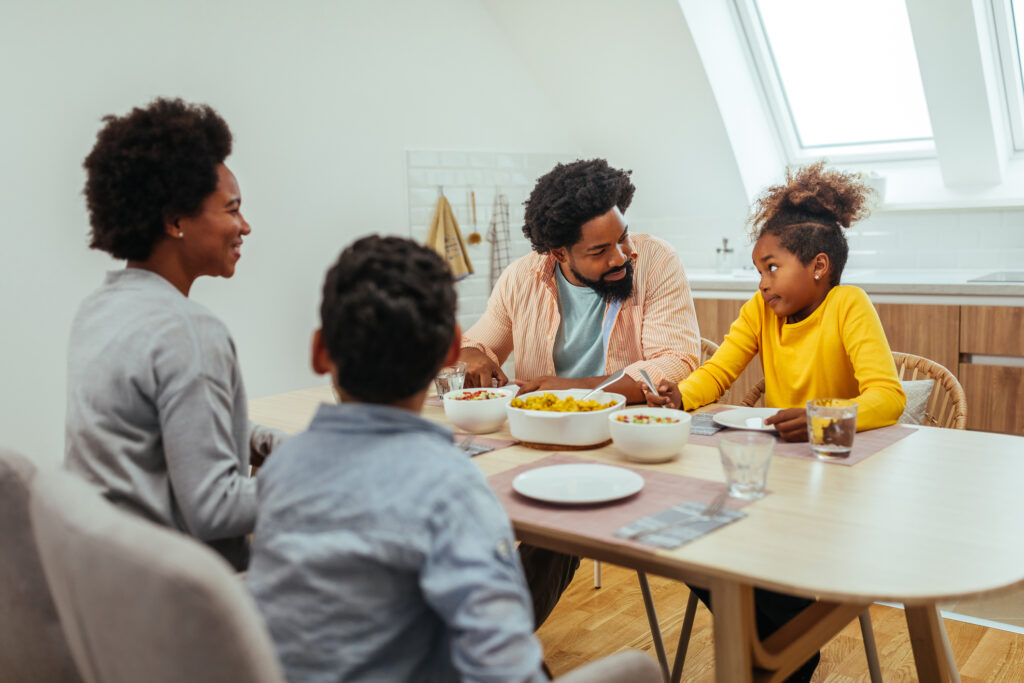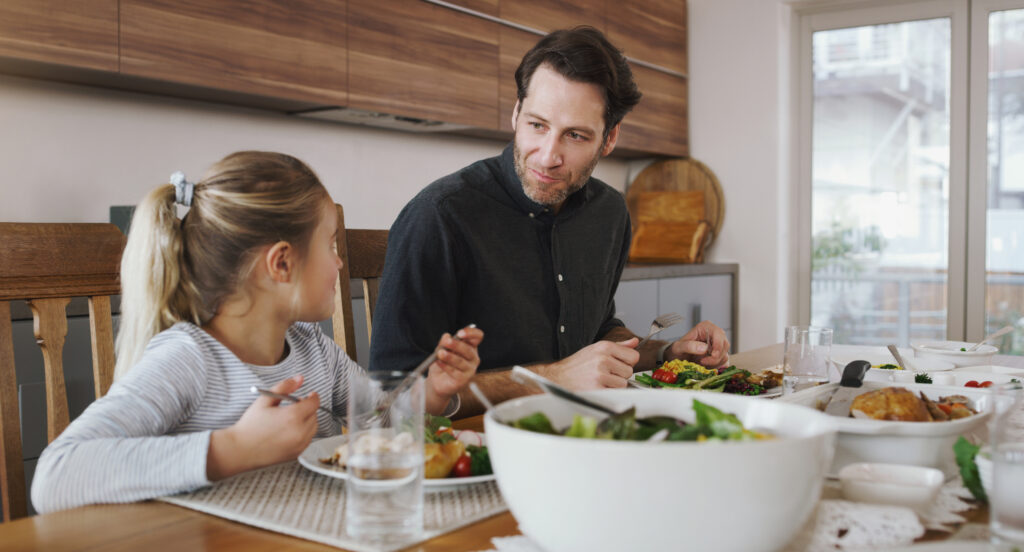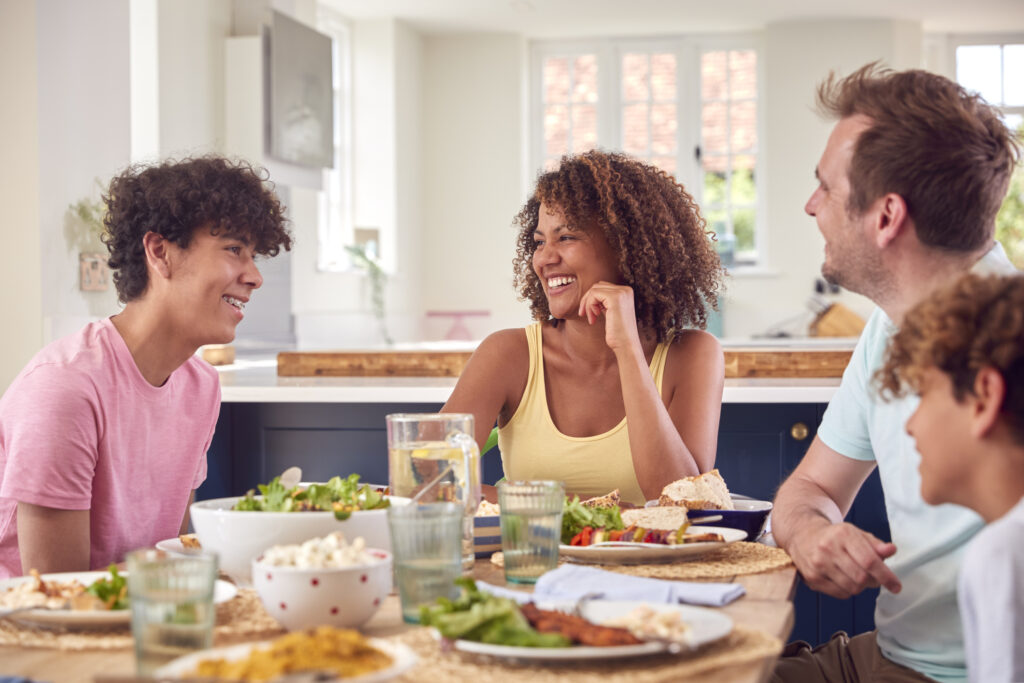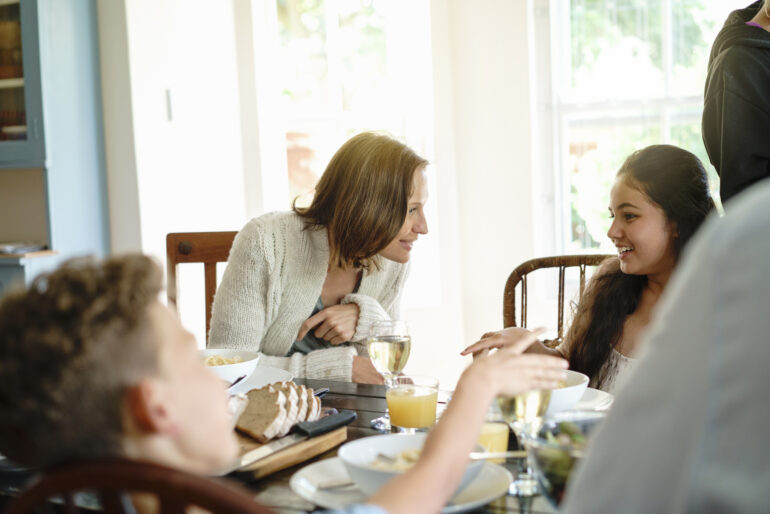Dinner conversations with kids often hit a wall: “How was school today?” “Fine.” But what if you could turn that routine question into a launchpad for deeper thinking?
Picture your family’s version of the following scenario. Instead of asking your kids to describe something they learned, try asking them to share one new question that crossed their mind that day — something they wondered about.
At first, you might be met with silence. Maybe even a bit of discomfort. Don’t rush to fill the gap. Just wait.
Eventually, your 9-year-old daughter speaks up. “In social studies, we were learning about the American Revolution,” she says. Then she pauses before adding, “I wondered… why do countries have revolutions, anyway?”

It’s a thoughtful question — one you hope her teacher encourages kids to explore. But how can you take that curiosity and guide her toward deeper thinking about this and other complex ideas?
That’s where “thinking routines” come in. At Project Zero, an educational research organization at the Harvard Graduate School of Education, we’ve created a panoply of “thinking routines” that prompt students to go beyond the surface and dig deep. These simple interventions, developed for use in the classroom, are now in schools and museums around the world.
But, they also have a place at home and can transform your family dinner conversations. Here’s how to use Project Zero thinking routines at home with your family.
Start With a Simple Question
Suppose you turn to your daughter and ask how she would answer her own question. After some thought, she says, “I guess countries have revolutions to get rid of the bad guys.”
This is a perfect opportunity to introduce one of Project Zero’s simplest thinking routines and follow up with, “What makes you say that?”
This question encourages evidence-based reasoning — and your daughter’s puzzled expression shows she’s thinking.
You suggest she talk it through with her 13-year-old brother. As they discuss, you quietly observe. Your kids begin questioning whether there is always a good side and a bad side or whether both sides might believe they’re fighting for the right cause.
Spark Debate
Now that they’re engaged, it’s time to challenge them with another thinking routine: Circle of Viewpoints.
You ask your children to think about the different perspectives of the British and the then-rebelling colonies. You suggest that your daughter take the perspective of a Revolutionary leader and your son the perspective of a British leader. You ask each of them to talk about how they see the situation from their perspective; you might then follow up with a question about the perspective they chose.
For example, “Did you wonder what makes each side believe what they believe?” “Did they pick up their attitudes from their families, their neighbors, their teachers, and the press?” “Were there even newspapers in the colonies in the 18th century?”
If you’ve succeeded, you’ll likely witness them wrestling with and wondering about two conflicting perspectives.

Introduce Big Questions
Perhaps that’s enough for one meal — a solid “first supper.” But if your children seem engaged, at your next family dinner you could introduce another Project Zero routine: Hotspots.
You make a statement that you know is sometimes true and sometimes false, such as, “Violence is more effective than non-violent methods when a group or country wants to be free.”
Then, you ask whether this statement is clearly true, clearly false, or somewhere in between.
If your kids initially disagree, that’s a plus. Their back-and-forth will likely lead to an important realization: often, a statement won’t always be true or false. Instead, it will depend on the situation.
Encourage Reflection
To wrap up the discussion, try a final thinking routine: I used to think/now I think.
“Think about what you have each learned from our discussions about revolutions,” you say. “Try to complete these sentences: I used to think… Now I think… “
Chances are, your kids will reflect thoughtfully, and you’ll be pleased they didn’t spend dinner looking at their phone or acting bored or eager to be excused. If you’re feeling encouraged, try another thinking routine the next night.
Shift to Visual Thinking
You call up an image of the famous painting, Washington Crossing the Delaware, and invoke the See Think Wonder routine by asking, “What do each of you see here? Just describe what you see.”
Give them time to look and speak. They’ll probably seem amazed at how much they notice when they look closely — almost competing to find new details.
Push for Deeper Thinking
After about 10 minutes, you ask them another question: “What do you think about this painting?”
To challenge any unsupported statements, you could revert to an earlier routine by asking, “What do you see that makes you say that?”
Try to avoid prompting them with questions unlikely to yield nuanced thinking. By steering away from questions like “Do you like it?” or “Who painted this?” you keep the focus on observation, interpretation, and curiosity.

Empower Kids to Lead the Conversation
If your kids enjoy these discussions, they can take turns directing these kinds of conversations with topics that pique their curiosity. They can also bring these routines into school discussions.
What started as a simple dinner conversation has become something bigger: a chance for your kids to think more deeply, ask meaningful questions, and explore ideas in a way that sticks with them.
The Takeaway
Thinking routines like these aren’t just tools for encouraging curiosity — they’re also a way to make family dinners more meaningful. Research has consistently shown that regular family meals offer a wide range of benefits, from improved mental and physical health to stronger academic performance.
As Anne Fishel, executive director of the Family Dinner Project, explains, “Regular family dinners are associated with lower rates of depression, and anxiety, and substance abuse, and eating disorders, and tobacco use, and early teenage pregnancy, and higher rates of resilience and higher self esteem.” By weaving thoughtful conversations into your meals, you’re not just helping your kids develop critical thinking skills — you’re strengthening connections, fostering resilience, and building a foundation for lasting family traditions.
So the next time you’re gathered around the table, consider swapping routine questions for richer conversations. With just a few simple thinking routines, you can transform dinner from a daily task into an opportunity to nourish your family’s minds — and their well-being.
How to Help
Project Zero is an education research group founded in 1967 located at the Harvard Graduate School of Education. Funded only by grants and gifts, Project Zero develops educational frameworks, which have been adopted by educators all over the world, to promote thinking and understanding. Donate today to support this work.


Ellen Winner is Professor Emerita of Psychology at Boston College and Senior Research Associate at Project Zero. She has authored five books–Invented Worlds: The Psychology of the Arts (1982), The Point of Words: Children’s Understanding of Metaphor and Irony (1988), Gifted Children: Myths and Realities (1996), How Art Works: A Psychological Exploration (2019), and An Uneasy Guest in the Schoolhouse: Art Education from Colonial Times to a Promising Future (2022), and has also co-authored five books: Studio Thinking: The Real Benefits of Visual Arts Education (2007), Studio Thinking 2 (2013), Studio Thinking 3 (2022), Studio Thinking from the Start: The K-8 Art Educator’s Handbook (2018), and The Child as Visual Artist (2022). She was the editor of the Arts PROPEL handbooks and PI of the Reviewing Education and the Arts Project (REAP). She is currently investigating the impact of Project Zero’s many educational frameworks and tools developed since the founding pf Project Zero in 1967.
She has served as President of APA’s Division 10, Psychology and the Arts in 1995-1996, and received the Rudolf Arnheim Award for Outstanding Research by a Senior Scholar in Psychology and the Arts from Division 10 in 2000. She is a fellow of APA Division 10 and of the International Association of Empirical Aesthetics.

